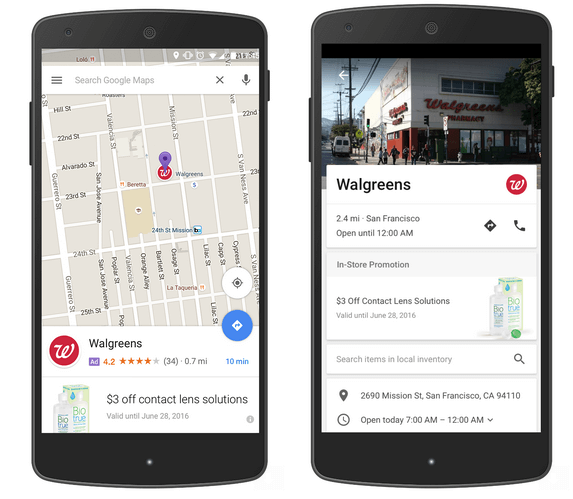Saying a third of mobile searches are local, Google brings “Promoted Pins” to Maps
Local searches are growing 50 percent faster than mobile searches overall.

Google has experimented with ads in Google Maps off and on for years. But in the “mobile first” era, it’s getting much more serious about ads on Maps.
Among a number of announcements coming out of Google’s Performance Summit today, the company is introducing the “next generation of local search ads” on Google and Google Maps (apps and mobile web). The company is also bringing what it calls more “branded and customized experiences” for marketers to Google Maps.
Recently, it began showing ads in the Local Finder. Now, the company is introducing “promoted pins” or “promoted locations” on Maps (below, left). Users will see branded pins along their route or nearby. It’s worth noting that Mapquest has done this for quite a few years.
Marketers will need to use location extensions to appear in promoted pins. Google also says it’s still testing and experimenting with formats, so we’re likely to see an evolution of this over time.
New-look local pages (below, right) will also offer new features and customization. Businesses will be able to include a range of content types, as appropriate to their category. For example, retailers can include local product inventory (provided they have an inventory feed going to Google). Marketers can also include promotions and discounts to encourage store visits.
Indeed, the purpose of these ads is to drive offline foot traffic and conversions, which Google says are outpacing e-commerce transactions for many marketers. To capture and illustrate that phenomenon, Google discussed its AdWords Store Visits, which has to date only been available to large brands and retailers. The company says that it has “measured over 1 billion store visits globally” in the two years since the introduction of Store Visits.
During the Performance Summit, Google’s AdWords VP, Jerry Dischler, indicated that the company was seeking to greatly expand availability of Store Visits data, including to small businesses over time. He said, however, that was a more challenging proposition and probably would require a “hardware solution” (e.g., beacons) because of challenges with accuracy and scale.
It’s very much in Google’s interest to make online-to-offline metrics available to as many marketers as possible. In a case study presented during a press briefing on Monday, Dischler said that Nissan in the UK found, though Store Visits, that “six percent of mobile ad clicks result in a trip to a dealership, delivering an estimated 25x return on investment.”
While Google has offered a range of different “local as a percent of overall mobile search” metrics in the past, the company said that local searches on mobile devices are growing 50 percent faster than mobile searches overall.
Contributing authors are invited to create content for Search Engine Land and are chosen for their expertise and contribution to the search community. Our contributors work under the oversight of the editorial staff and contributions are checked for quality and relevance to our readers. The opinions they express are their own.
Related stories
New on Search Engine Land
